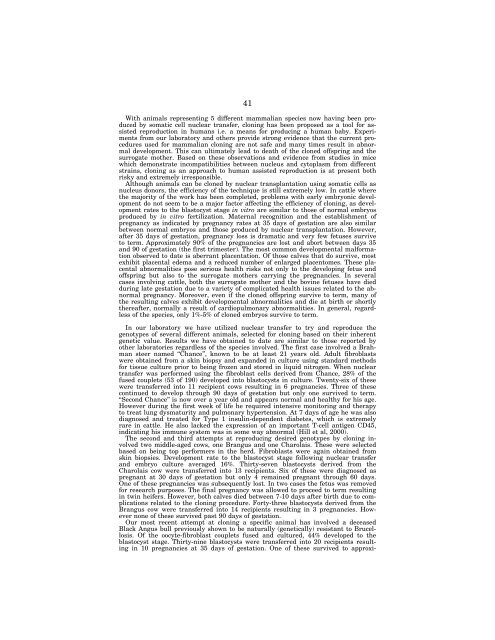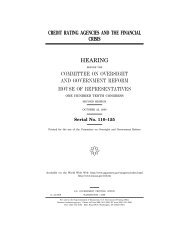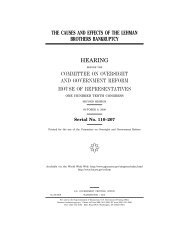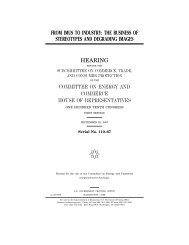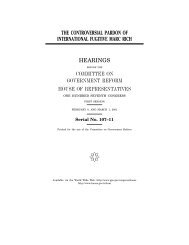40really have a clue what those genes are at this time. It could beany of 30,000 genes or more and we really don’t have a clue. Youcan’t do genetic analysis of 30,000 genes and you can’t do pre-implantationdiagnostics of PDG to try and determine if those genesare abnormally expressed. It’s just something that can’t be done.We don’t have the technology available to do that yet and youcouldn’t do it on pre-implantation. The closest you could get to, asreferred to is you could get to something like ultrasound, but atthat case you’re basically going say the fetus is dead, the calf isdead, it’s dying, it has problems.So this concept that you’re going to be able to screen pregnanciesand embryos, there’s just no basis for that in terms of how wewould actually be able to do it because the technology is simply notavailable.I guess I’ll quit there, since I’ve run out of my time.[The prepared statement of Mark E. Westhusin follows:]PREPARED STATEMENT OF MARK E. WESTHUSIN, ASSOCIATE PROFESSOR, COLLEGE OFVETERINARY MEDICINE, TEXAS A&M UNIVERSITYMan has long been interested in nuclear transplantation both as a tool to studydevelopmental biology and as a means for producing genetically identical animals.The basic technique involves the transfer of a nucleus from one cell to another cellwhich has had its own nucleus removed. For cloning animals this entails transferringthe nucleus of a cell obtained from the individual to be cloned into anunfertilized ovum that has had its chromosomes removed. If successful, the transferrednucleus is re-programmed so to direct development of a new embryo that isgenetically identical to the animal from which the cell was obtained. This embryocan then be transferred into a surrogate mother for gestation to term and birth ofa clone.In recent years, nuclear transplantation has been employed to clone a number ofdifferent animals. The most acclaimed example is of course the report by Wilmutet al (1997), which was the first to demonstrate cloning of adult mammals was possible.Nuclei of cultured mammary epithelial cells derived from an adult ewe weretransferred into enucleated sheep ova, ultimately resulting in the birth of a clonedlamb (Dolly). The demonstration that adult cells could be used for cloning mammalssparked enormous new interest in exploring the potential of cloning animals. As aresult, in just the past three years, cloned cattle, sheep, goats, pigs, and mice havebeen reported.The potential benefits animal cloning will afford mankind are far-reaching, andundoubtedly, many more applications and benefits are yet to be imagined. A currentutility includes the production of transgenic animals for use as living bioreactors toproduce pharmaceuticals. Several products produced in milk of transgenic sheep andgoats are already in clinical trials (Factor IX, P.P.L., Inc.; anti-thrombin III,Genzyme Inc.; and the estimated market value of pharmaceutical production in themilk of transgenic animals currently exceeds $3 billion per year. A number of otherproducts are targeted for production in milk from transgenic livestock includingboth nutriceuticals and vaccines. Genetic engineering animals for protein productionin milk promises to result in a wide variety of products for human use, many ofwhich will be less expensive and more effective. Other applications of cloning toproduce transgenic animals include the production of livestock that are that are geneticallyresistant to devastating diseases such as those currently causing majorconcern throughout the world i.e. Mad Cow Disease and Foot and Mouth disease.Agricultural applications of animal cloning will result in increased quality and decreasedcosts for food and fiber. In addition, animal cloning provides for rapid geneticgain in animal breeding programs and could potentially have a great beneficialimpact on the conservation, preservation and propagation of endangered species.Anticipated future applications of cloning procedures are nothing short of phenomenal.These include such things as the production of human embryonic stemcells for tissue transplantation and/or gene therapy and treatments formitochondrial diseases, just to name a few. Human cells could potentially be utilizedas nuclear donors for transplantation into oocytes, resulting in cell lines that maybe useful for human therapy to treat conditions such as Alzheimer’s or Parkinson’sdisease.VerDate 11-MAY-2000 07:46 May 24, 2001 Jkt 000000 PO 00000 Frm 00044 Fmt 6633 Sfmt 6621 71495.TXT HCOM2 PsN: HCOM2
41With animals representing 5 different mammalian species now having been producedby somatic cell nuclear transfer, cloning has been proposed as a tool for assistedreproduction in humans i.e. a means for producing a human baby. Experimentsfrom our laboratory and others provide strong evidence that the current proceduresused for mammalian cloning are not safe and many times result in abnormaldevelopment. This can ultimately lead to death of the cloned offspring and thesurrogate mother. Based on these observations and evidence from studies in micewhich demonstrate incompatibilities between nucleus and cytoplasm from differentstrains, cloning as an approach to human assisted reproduction is at present bothrisky and extremely irresponsible.Although animals can be cloned by nuclear transplantation using somatic cells asnucleus donors, the efficiency of the technique is still extremely low. In cattle wherethe majority of the work has been completed, problems with early embryonic developmentdo not seem to be a major factor affecting the efficiency of cloning, as developmentrates to the blastocyst stage in vitro are similar to those of normal embryosproduced by in vitro fertilization. Maternal recognition and the establishment ofpregnancy as indicated by pregnancy rates at 35 days of gestation are also similarbetween normal embryos and those produced by nuclear transplantation. However,after 35 days of gestation, pregnancy loss is dramatic and very few fetuses surviveto term. Approximately 90% of the pregnancies are lost and abort between days 35and 90 of gestation (the first trimester). The most common developmental malformationobserved to date is aberrant placentation. Of those calves that do survive, mostexhibit placental edema and a reduced number of enlarged placentomes. These placentalabnormalities pose serious health risks not only to the developing fetus andoffspring but also to the surrogate mothers carrying the pregnancies. In severalcases involving cattle, both the surrogate mother and the bovine fetuses have diedduring late gestation due to a variety of complicated health issues related to the abnormalpregnancy. Moreover, even if the cloned offspring survive to term, many ofthe resulting calves exhibit developmental abnormalities and die at birth or shortlythereafter, normally a result of cardiopulmonary abnormalities. In general, regardlessof the species, only 1%-5% of cloned embryos survive to term.In our laboratory we have utilized nuclear transfer to try and reproduce thegenotypes of several different animals, selected for cloning based on their inherentgenetic value. Results we have obtained to date are similar to those reported byother laboratories regardless of the species involved. The first case involved a Brahmansteer named ‘‘Chance’’, known to be at least 21 years old. Adult fibroblastswere obtained from a skin biopsy and expanded in culture using standard methodsfor tissue culture prior to being frozen and stored in liquid nitrogen. When nucleartransfer was performed using the fibroblast cells derived from Chance, 28% of thefused couplets (53 of 190) developed into blastocysts in culture. Twenty-six of thesewere transferred into 11 recipient cows resulting in 6 pregnancies. Three of thesecontinued to develop through 90 days of gestation but only one survived to term.‘‘Second Chance’’ is now over a year old and appears normal and healthy for his age.However during the first week of life he required intensive monitoring and therapyto treat lung dysmaturity and pulmonary hypertension. At 7 days of age he was alsodiagnosed and treated for Type 1 insulin-dependent diabetes, which is extremelyrare in cattle. He also lacked the expression of an important T-cell antigen CD45,indicating his immune system was in some way abnormal (Hill et al, 2000).The second and third attempts at reproducing desired genotypes by cloning involvedtwo middle-aged cows, one Brangus and one Charolais. These were selectedbased on being top performers in the herd. Fibroblasts were again obtained fromskin biopsies. Development rate to the blastocyst stage following nuclear transferand embryo culture averaged 16%. Thirty-seven blastocysts derived from theCharolais cow were transferred into 13 recipients. Six of these were diagnosed aspregnant at 30 days of gestation but only 4 remained pregnant through 60 days.One of these pregnancies was subsequently lost. In two cases the fetus was removedfor research purposes. The final pregnancy was allowed to proceed to term resultingin twin heifers. However, both calves died between 7-10 days after birth due to complicationsrelated to the cloning procedure. Forty-three blastocysts derived from theBrangus cow were transferred into 14 recipients resulting in 3 pregnancies. Howevernone of these survived past 90 days of gestation.Our most recent attempt at cloning a specific animal has involved a deceasedBlack Angus bull previously shown to be naturally (genetically) resistant to Brucellosis.Of the oocyte-fibroblast couplets fused and cultured, 44% developed to theblastocyst stage. Thirty-nine blastocysts were transferred into 20 recipients resultingin 10 pregnancies at 35 days of gestation. One of these survived to approxi-VerDate 11-MAY-2000 07:46 May 24, 2001 Jkt 000000 PO 00000 Frm 00045 Fmt 6633 Sfmt 6621 71495.TXT HCOM2 PsN: HCOM2
- Page 1 and 2: ISSUES RAISED BY HUMAN CLONING RESE
- Page 3 and 4: C O N T E N T SPageTestimony of:Boi
- Page 5 and 6: ISSUES RAISED BY HUMAN CLONINGRESEA
- Page 7 and 8: 3Would human cloning lessen the wor
- Page 9 and 10: 5Chairman TAUZIN. Thank you, Mr. Ch
- Page 11 and 12: 7and cell therapy and beta cell dev
- Page 13: 9safety and the moral condition of
- Page 17 and 18: 13seen in the common phrase, being
- Page 20 and 21: 16a want of capacity to live were a
- Page 22 and 23: 18eight to ten weeks gestation as a
- Page 24 and 25: 20Washington v. Glucksberg ignores
- Page 26 and 27: 22tion decision. The father of ‘
- Page 28 and 29: 24been treated as ‘‘sui generis
- Page 30 and 31: 26Perhaps the three most compelling
- Page 32 and 33: 28are their genes. We know that chi
- Page 34 and 35: 30ago, Nobel Prize-winning biologis
- Page 36 and 37: 32Mr. JOHN. Thank you, Mr. Chairman
- Page 38 and 39: 34Mr. GREENWOOD. The Chair thanks t
- Page 40 and 41: 36to turn undifferentiated human pl
- Page 42 and 43: 38these issues have not yet even be
- Page 46 and 47: 42mately 150 days of gestation and
- Page 48 and 49: 44Hill JR, Winger QA, Long CR, Loon
- Page 50 and 51: 46clones will not change a bit by t
- Page 52 and 53: 48technologies, we’re able today
- Page 54 and 55: 50from the testes of infertile men
- Page 56 and 57: 52not be taken away from people, be
- Page 58 and 59: 54a result of this declaration, I w
- Page 60 and 61: 56Too much pressure, too many expec
- Page 62 and 63: 58requires some level of scientific
- Page 64 and 65: 60an abnormal person. So I think it
- Page 66 and 67: 62to the world, back to this earthl
- Page 68 and 69: 64which is not true for cow which i
- Page 70 and 71: 66Ms. BOISSELIER. University of Hou
- Page 72 and 73: 68Ms. BOISSELIER. Soon.Ms. DEGETTE.
- Page 74 and 75: 70Mr. ZAVOS. No, no. We believe tha
- Page 76 and 77: 72cloning process. And without that
- Page 78 and 79: 74have to look at the structure of
- Page 80 and 81: 76Mr. LARGENT. So the answer is no,
- Page 82 and 83: 78that very much and you are excuse
- Page 84 and 85: 80that people have incorrectly stat
- Page 86 and 87: 82My name is Dr. Thomas Murray. I
- Page 88 and 89: 84human subjects against irresponsi
- Page 90 and 91: 86might be born as a result of this
- Page 92 and 93: 88ever, it is not unusual for the g
- Page 94 and 95:
90Mr. DEUTSCH. Because there really
- Page 96 and 97:
92Ms. ZOON. When we found out about
- Page 98 and 99:
94Mr. GREENWOOD. The time of the ge
- Page 100 and 101:
96Be that as it may I think there a
- Page 102 and 103:
98There has been progress in the cl
- Page 104 and 105:
100may find that it is a terrible e
- Page 106 and 107:
102entists tried to get this ban ov
- Page 108 and 109:
104lies in our hands. And we face a
- Page 110 and 111:
106clude Ireland, Israel, Italy, Fr
- Page 112 and 113:
108strict IVF and similar high-tech
- Page 114 and 115:
110while ‘‘clone then love’
- Page 116 and 117:
112What Cloning Is Not—The ‘‘
- Page 118 and 119:
114And the largest group of people
- Page 120 and 121:
116The last piece to the legal puzz
- Page 122 and 123:
118cloning law on both scientific f
- Page 124 and 125:
120mendous potential human safety r
- Page 126 and 127:
122age him to do this research and
- Page 128 and 129:
124I realize there have been calls
- Page 130 and 131:
126‘‘from which I have no assoc
- Page 132 and 133:
128TO HAVE CHILDREN,’’ I ask th
- Page 134 and 135:
130of ourselves as humans in our pr
- Page 136 and 137:
132Our Genetic Science Task Force c
- Page 138 and 139:
134But this was also true in occide
- Page 140 and 141:
136So we utilized good science to d
- Page 142 and 143:
138egg and so on. What you’re tal
- Page 144 and 145:
140Mr. DEUTSCH. I think that’s ac
- Page 146 and 147:
142and dad? We all did that when we
- Page 148 and 149:
144Food, Drug and Cosmetics Act or
- Page 150 and 151:
146Mister Chairman, the embryo may
- Page 152 and 153:
148The current low rate of cloning
- Page 154 and 155:
150TIME magazine’s pictorial, ‘
- Page 156 and 157:
152John A. Robertson, University of


